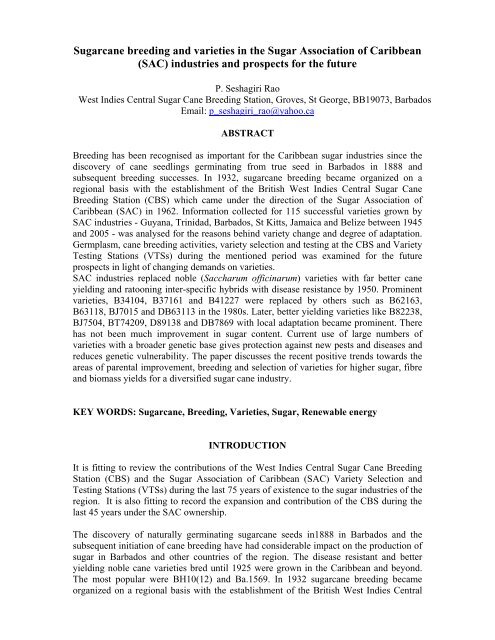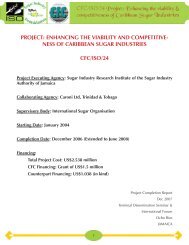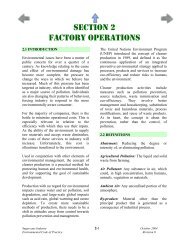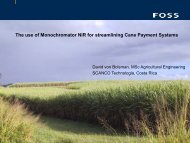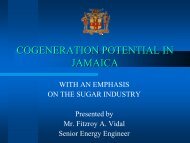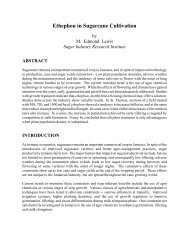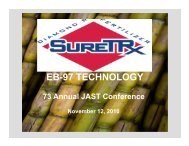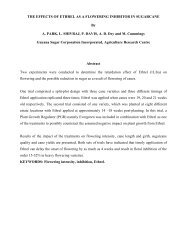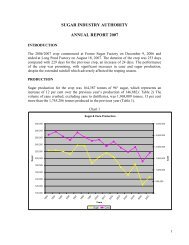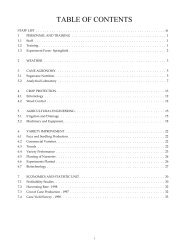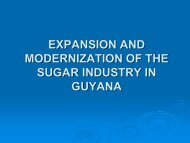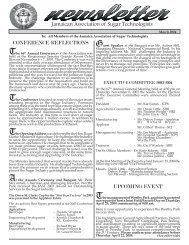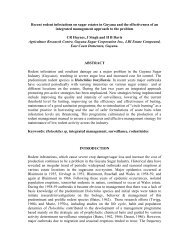Sugarcane breeding and varieties.pdf - The Jamaican Sugar Industry
Sugarcane breeding and varieties.pdf - The Jamaican Sugar Industry
Sugarcane breeding and varieties.pdf - The Jamaican Sugar Industry
Create successful ePaper yourself
Turn your PDF publications into a flip-book with our unique Google optimized e-Paper software.
<strong><strong>Sugar</strong>cane</strong> <strong>breeding</strong> <strong>and</strong> <strong>varieties</strong> in the <strong>Sugar</strong> Association of Caribbean<br />
(SAC) industries <strong>and</strong> prospects for the future<br />
P. Seshagiri Rao<br />
West Indies Central <strong>Sugar</strong> Cane Breeding Station, Groves, St George, BB19073, Barbados<br />
Email: p_seshagiri_rao@yahoo.ca<br />
ABSTRACT<br />
Breeding has been recognised as important for the Caribbean sugar industries since the<br />
discovery of cane seedlings germinating from true seed in Barbados in 1888 <strong>and</strong><br />
subsequent <strong>breeding</strong> successes. In 1932, sugarcane <strong>breeding</strong> became organized on a<br />
regional basis with the establishment of the British West Indies Central <strong>Sugar</strong> Cane<br />
Breeding Station (CBS) which came under the direction of the <strong>Sugar</strong> Association of<br />
Caribbean (SAC) in 1962. Information collected for 115 successful <strong>varieties</strong> grown by<br />
SAC industries - Guyana, Trinidad, Barbados, St Kitts, Jamaica <strong>and</strong> Belize between 1945<br />
<strong>and</strong> 2005 - was analysed for the reasons behind variety change <strong>and</strong> degree of adaptation.<br />
Germplasm, cane <strong>breeding</strong> activities, variety selection <strong>and</strong> testing at the CBS <strong>and</strong> Variety<br />
Testing Stations (VTSs) during the mentioned period was examined for the future<br />
prospects in light of changing dem<strong>and</strong>s on <strong>varieties</strong>.<br />
SAC industries replaced noble (Saccharum officinarum) <strong>varieties</strong> with far better cane<br />
yielding <strong>and</strong> ratooning inter-specific hybrids with disease resistance by 1950. Prominent<br />
<strong>varieties</strong>, B34104, B37161 <strong>and</strong> B41227 were replaced by others such as B62163,<br />
B63118, BJ7015 <strong>and</strong> DB63113 in the 1980s. Later, better yielding <strong>varieties</strong> like B82238,<br />
BJ7504, BT74209, D89138 <strong>and</strong> DB7869 with local adaptation became prominent. <strong>The</strong>re<br />
has not been much improvement in sugar content. Current use of large numbers of<br />
<strong>varieties</strong> with a broader genetic base gives protection against new pests <strong>and</strong> diseases <strong>and</strong><br />
reduces genetic vulnerability. <strong>The</strong> paper discusses the recent positive trends towards the<br />
areas of parental improvement, <strong>breeding</strong> <strong>and</strong> selection of <strong>varieties</strong> for higher sugar, fibre<br />
<strong>and</strong> biomass yields for a diversified sugar cane industry.<br />
KEY WORDS: <strong><strong>Sugar</strong>cane</strong>, Breeding, Varieties, <strong>Sugar</strong>, Renewable energy<br />
INTRODUCTION<br />
It is fitting to review the contributions of the West Indies Central <strong>Sugar</strong> Cane Breeding<br />
Station (CBS) <strong>and</strong> the <strong>Sugar</strong> Association of Caribbean (SAC) Variety Selection <strong>and</strong><br />
Testing Stations (VTSs) during the last 75 years of existence to the sugar industries of the<br />
region. It is also fitting to record the expansion <strong>and</strong> contribution of the CBS during the<br />
last 45 years under the SAC ownership.<br />
<strong>The</strong> discovery of naturally germinating sugarcane seeds in1888 in Barbados <strong>and</strong> the<br />
subsequent initiation of cane <strong>breeding</strong> have had considerable impact on the production of<br />
sugar in Barbados <strong>and</strong> other countries of the region. <strong>The</strong> disease resistant <strong>and</strong> better<br />
yielding noble cane <strong>varieties</strong> bred until 1925 were grown in the Caribbean <strong>and</strong> beyond.<br />
<strong>The</strong> most popular were BH10(12) <strong>and</strong> Ba.1569. In 1932 sugarcane <strong>breeding</strong> became<br />
organized on a regional basis with the establishment of the British West Indies Central
<strong>Sugar</strong> Cane Breeding Station (CBS), Stevenson (1953). This heralded an era of improved<br />
production in the face of many challenges which continued under the direction of the<br />
<strong>Sugar</strong> Association of the Caribbean (SAC), formed in 1962, with the cooperation of the<br />
Variety Testing Stations (VTS) in a network comprising Guyana, Trinidad, Barbados, St<br />
Kitts, Jamaica <strong>and</strong> Belize which fuelled an expansion of cane <strong>breeding</strong> research leading<br />
to the development of many productive <strong>varieties</strong> (Walker, 1982, Rao, et. al. 1994, Chave,<br />
et. al., 1994, Kennedy, et. al.1994).<br />
Since the late 1960s, the West Indies <strong><strong>Sugar</strong>cane</strong> Breeding <strong>and</strong> Evaluation Network<br />
(WISBEN) has developed much needed <strong>varieties</strong> for the SAC member industries <strong>and</strong><br />
other associate members inside <strong>and</strong> outside the region. Inter-specific hybrid (I-SH)<br />
<strong>varieties</strong> completely replaced the nobles by 1950. I-SH <strong>varieties</strong> like B34104, B37161,<br />
B41227 <strong>and</strong> B4362 with wider adaptation <strong>and</strong> better ratooning capabilities were grown in<br />
many countries. From the 1980s onwards, <strong>varieties</strong> selected for local adaptation <strong>and</strong><br />
better cane yield have occupied large areas. <strong>The</strong> paper discusses cane <strong>breeding</strong> <strong>and</strong><br />
variety testing activities, variety changes between 1945 <strong>and</strong> 2005 <strong>and</strong> presents the current<br />
developments in the areas of parental improvement, <strong>breeding</strong> <strong>and</strong> selection for higher<br />
sugar, fibre <strong>and</strong> biomass yield for a diversifying sugar cane industry within the region.<br />
<strong><strong>Sugar</strong>cane</strong> <strong>breeding</strong><br />
<strong><strong>Sugar</strong>cane</strong> <strong>breeding</strong> for the SAC industries has been carried out by the CBS over the last<br />
75 years in the face of many challenges. <strong>The</strong> main challenges included <strong>breeding</strong> for pest<br />
<strong>and</strong> disease resistance, improved cane <strong>and</strong> sugar yield as well as local adaptation to<br />
changing cultural practices <strong>and</strong> harvest systems. <strong>The</strong> CBS acquired <strong>and</strong> maintained large<br />
numbers of wild germplasm representing many ecological <strong>and</strong> geographical regions of<br />
the world. It also obtained commercial parents as well as <strong>varieties</strong> for sugar production.<br />
In the 1930s <strong>and</strong> 1940s the CBS introduced new <strong>varieties</strong> with disease resistance, higher<br />
cane yields <strong>and</strong> longer ratooning capabilities to replace noble <strong>varieties</strong> then being grown.<br />
At present the live collection consists of over 3,700 clones representing distinct species,<br />
early generation inter-specific hybrids (EGISH) <strong>and</strong> commercial clones. <strong>The</strong> CBS<br />
conducted considerable research into areas such as flowering control, crossing methods,<br />
inheritance of cane yield, sugar accumulation, disease resistance <strong>and</strong> other important<br />
characteristics. Research into the parental choice, <strong>breeding</strong> systems, selection methods,<br />
data analysis <strong>and</strong> experimental designs for variety trials have led to effective <strong>and</strong> efficient<br />
variety development (Walker 1982).<br />
Two important long term parental improvement programmes, genetic base broadening<br />
(from 1960s) with the aim of introducing much needed genetic variability for continuous<br />
improvement of many characteristics <strong>and</strong> recent recurrent selection for increased sugar<br />
content have created unique populations with great potential for <strong>breeding</strong> <strong>varieties</strong> for<br />
better cane yield, sugar content <strong>and</strong> biomass (Walker, 1987; Simmonds, 1993; Rao <strong>and</strong><br />
Kennedy, 2004; Kennedy, 2005).<br />
<strong>The</strong> CBS routinely conducts workshops <strong>and</strong> training sessions for the VTSs <strong>and</strong> CBS’<br />
staffs <strong>and</strong> has been playing an active role in the exchange of <strong>varieties</strong> among the<br />
members of WISBEN to ensure exploitation of a wider germplasm. Senior staffers of the<br />
CBS from time to time visits VTSs to advise on various aspects of variety selection <strong>and</strong>
testing. <strong>The</strong> central role played by the CBS <strong>and</strong> the active part played by the VTSs in<br />
WISBEN contribute to a constant supply of productive <strong>varieties</strong>.<br />
All has been achieved with limited staff <strong>and</strong> small budgets over 75 years. This could not<br />
have happened had it not been for the employment <strong>and</strong> retention of well trained <strong>and</strong><br />
devoted plant breeders, the continuous cooperation from the VTSs as well as constant<br />
support from sugar industry authorities, <strong>and</strong> in recent times by SAC. <strong>The</strong> contributions of<br />
the station’s long serving former directors - Dr A.E.S. McIntosh, 1928-1945; Mr. G.C.<br />
Stevenson, 1932-1962; Mr. D.I.T. Walker, 1957-1988; Dr. P. Seshagiri Rao, 1968-2008<br />
cannot be over emphasized. <strong>The</strong> work of other research <strong>and</strong> technical staff of the CBS<br />
<strong>and</strong> VTSs <strong>and</strong> the inputs of the renowned plant breeder, Prof. N.W. Simmonds as<br />
consultant, 1962-1992, contributed to the success. In plant <strong>breeding</strong> it is important to<br />
retain breeders over long periods, ensuring overlap of personnel for continuity of long<br />
term <strong>breeding</strong> programmes. <strong>The</strong> transition to the current Director, Dr A.J. Kennedy, with<br />
over 22 years of experience at CBS, is in keeping with that tradition.<br />
Variety selection <strong>and</strong> testing<br />
Decentralised selection of <strong>varieties</strong> from seedlings raised from the fuzz <strong>and</strong> testing of<br />
imported clones for local adaptation, starting from late 1950s, contributed enormously to<br />
the development of well adapted <strong>and</strong> productive <strong>varieties</strong>. <strong>The</strong> main active SAC VTSs<br />
were in Guyana, Trinidad, Barbados, St Kitts, Jamaica <strong>and</strong> Belize. A few other VTSs<br />
inside <strong>and</strong> outside region also participate in the variety development. <strong>The</strong> VTSs are<br />
responsible to select well adapted <strong>varieties</strong> for the respective local growing conditions<br />
taking into consideration cane yield, sugar content, ratooning, pest <strong>and</strong> disease resistance,<br />
herbicide sensitivity, h<strong>and</strong> <strong>and</strong> mechanical harvest suitability <strong>and</strong> other characteristics.<br />
Over the years SAC industries maintained well established VTSs <strong>and</strong> retained well<br />
trained <strong>and</strong> experienced staff with few exceptions. Raising approximately 200,000<br />
seedlings every year in the region <strong>and</strong> subjecting them to selection in early stages <strong>and</strong><br />
testing in advanced stages requires, in addition to considerable physical resources, a cadre<br />
of well trained <strong>and</strong> experienced selectors. Changes in variety requirements meant<br />
changing the variety selection procedures <strong>and</strong> upgrading the cane analysis laboratories.<br />
Since selectors are often also in charge of variety extension <strong>and</strong> work closely with the<br />
cultivation managers, they bring useful field information on the <strong>varieties</strong> <strong>and</strong> often make<br />
necessary changes needed in the selection procedures. Frequent interactions between the<br />
CBS <strong>and</strong> WISBEN staffs provide the forum to address problems <strong>and</strong> guide the selectors<br />
to adopt changes that may be needed.
Challenges <strong>and</strong> Variety Change<br />
After replacing the nobles with better yielding I-SH <strong>varieties</strong> with longer ratooning<br />
capabilities <strong>and</strong> with mosaic <strong>and</strong> gumming disease resistance, the industries faced a series<br />
of challenges including the onset of new diseases, changing cultivation practices,<br />
introduction of herbicides, mechanization, increased cost of production <strong>and</strong> reduced<br />
income, especially since the 1970s. <strong>The</strong>se conditions imposed the need for <strong>varieties</strong> of<br />
different characteristics to maintain sugar yields <strong>and</strong> ensure survival of the industries.<br />
<strong>The</strong> potentially devastating diseases arriving in the region were leaf scald (Xanthomonas<br />
albilineans) in 1950s <strong>and</strong> smut (Ustilago scitaminea) in 1970s. Leaf scald affected a few<br />
<strong>varieties</strong> sporadically <strong>and</strong> became endemic in some areas. Certain high sugar yielding <strong>and</strong><br />
widely grown <strong>varieties</strong> proved susceptible to smut. Other diseases with less effect were<br />
rust (Puccinia melanocephala), yellow spot (Mycovellosiella koepkei), ratoon stunting<br />
disease (Clavibacter xyli) <strong>and</strong> more recently yellow leaf disease (luteovirus). Fortunately,<br />
the availability <strong>and</strong> replacement of <strong>varieties</strong> with varying levels of disease tolerance or<br />
resistance over time resulted in very low levels of yield loss to the industries.<br />
<strong>The</strong> pace of change of <strong>varieties</strong> varied considerably from industry to industry. <strong>The</strong><br />
percentage of area occupied by different <strong>varieties</strong> in the six SAC countries is given in<br />
Tables 1-6.<br />
In Guyana within a short time noble <strong>varieties</strong> were replaced by I-SH <strong>varieties</strong>, first with<br />
B34104 <strong>and</strong> soon after, when this was found susceptible to leaf scald, by B37161 <strong>and</strong><br />
B41227 (Table 1). When smut arrived in the mid 1970s, two prominent but susceptible<br />
<strong>varieties</strong>, HJ5741 <strong>and</strong> DB41460, were quickly replaced with smut resistant <strong>varieties</strong>.<br />
B41227, with wider adaptation <strong>and</strong> resistance to smut, continued to play an important<br />
role until early 1990s. Good collaboration between the selection department <strong>and</strong> field<br />
management coupled with Guyana’s excellent tradition of variety selection, from fuzz<br />
produced locally <strong>and</strong> received from CBS, ensured that a large number of substitute<br />
<strong>varieties</strong> were available with none occupying more than 40% of acreage.
Table 1: Percent Area occupied by Varieties in Guyana from 1945 to 2005<br />
Variety 1945 1950 1955 1960 1965 1970 1975 1980 1985 1990 1995 2000 2005<br />
Diamond<br />
10 27<br />
POJ2878 55<br />
Co419 5 5 1<br />
Co421 6 9<br />
D14/34 3<br />
B34104 58 13<br />
B37161 1 30 36 20 3<br />
B4098 10 1<br />
B41227 34 42 47 35 31 43 24 21 11 4<br />
B4362 5 2<br />
B47258 8 2 1 2 3<br />
D141/46 13 29 10 6 5 5 5<br />
D37/45 3 5<br />
B51116 3 10 8<br />
D158/41 2 3 1 1 5 5 5 7 7<br />
D38/57 6 7 3 1<br />
HJ5741 17<br />
DB414/60 11<br />
DB66113 12 29 35 19 15 6<br />
B63118 7 4 1<br />
DB671760 1 5 9 2 1<br />
DB7160 2 8 9 7<br />
DB7869 1 22 34 33<br />
DB75159 1 12 12 6<br />
DB7047 2 11 4<br />
DB70172 1 3<br />
D89138 2 20<br />
D7661 2 12<br />
D8415 10<br />
D9017 6<br />
DB83119 2<br />
R570 2<br />
This kind of variety replacement <strong>and</strong> cooperation proved its worth in increasing sugar<br />
production during a period of unprecedented changes in growing conditions.
Table 2: Percent area occupied by <strong>varieties</strong> in Trinidad from 1945 to 2005<br />
Variety 1945 1950 1955 1960 1965 1970 1975 1980 1985 1990 1995 2000 2005<br />
BH10(12) 21<br />
C0213 29<br />
B3337 7 9 32 17 2<br />
B34104 24 37 7<br />
B37161 18 21 15 2<br />
B37172 11 31 18 3<br />
B41227 4 36 61 60 70 77 77 53 40 30 19<br />
B4362 3 1 2 1<br />
B49119 2 14 26 5 1<br />
B50112 6 6<br />
HJ5741 19 14<br />
BT64134 3 5<br />
B63118 7 6 2<br />
B62163 4 3<br />
BB66113 1 12 14 12 15<br />
BT74209 1 13 32 31<br />
BT72842 6 10 3 3<br />
B80689 4 13 14<br />
BJ7015 1 3<br />
BT871646 1 3<br />
DB7869 1<br />
In Trinidad, following the replacement of nobles with I-SH <strong>varieties</strong>, there has been a<br />
relatively slow change in the variety picture (Table 2). B41227 introduced in early 1950s<br />
occupied large areas up to 1990s, reaching a high of 87% in 1982. Fortunately, this<br />
variety showed resistance to most diseases. Varieties selected elsewhere, especially in<br />
Barbados <strong>and</strong> Guyana, dominated the picture. Only recently, after more than 40 years of<br />
selection from fuzz produced by the CBS, has a locally selected variety, BT74209,<br />
reached an acreage of 32% in 2000.<br />
In Barbados, variety change from nobles to I-SH was relatively quick with B37161<br />
occupying 90% of acreage by 1950 (Table 3). Soon after there was a continuous<br />
replacement of <strong>varieties</strong> with B62163 being the most successful reaching 84% in 1984. In<br />
general, Barbados has tended to grow a relatively wide mixture of <strong>varieties</strong>, except for a<br />
period when the industry was going through financial constraints, leading to the long<br />
ratooning of B62163. During the last 15 years however, a wider mixture of <strong>varieties</strong> have<br />
been grown with newer <strong>varieties</strong>, bred after 1985, showing much promise for expansion.<br />
In St Kitts variety change has been gradual with new <strong>varieties</strong> being tested continuously<br />
<strong>and</strong> replacing the older set (Table 4). Being a small industry, instead of selecting<br />
<strong>varieties</strong> from seedlings raised from fuzz, St Kitts adopted a policy of importing <strong>and</strong><br />
testing approximately 200 <strong>varieties</strong> selected from Stage 2 in Barbados <strong>and</strong> a few from
other SAC industries. With a good variety testing programme, St Kitts did very well in<br />
variety development without going into the expensive seedling selection process.<br />
Table 3: Percent area occupied by <strong>varieties</strong> in Barbados from 1945 to 2005<br />
Variety 1945 1950 1955 1960 1965 1970 1975 1980 1985 1990 1995 2000 2005<br />
BH10(12) 5<br />
B726 3<br />
B2935 2<br />
B3439 5<br />
B34104 7<br />
B37187 10 1<br />
B37161 63 90 67 8<br />
B4098 5 8 3<br />
B41211 2 13 26 10 8<br />
B45151 1 18 17 7<br />
B4744 4 26 28 31 14 2<br />
B49119 15 31 22<br />
B52107 1 5 2<br />
B54142 5 2<br />
B60267 1 11 3<br />
B62163 10 40 59 79 67 24 7<br />
B63118 3 16 13 4 3<br />
B59162 19 5<br />
B80689 3 20 9 11<br />
B77602 5 15 22 16<br />
B74541 1 12 17 11 13<br />
B80251 6 9 4<br />
B82238 2 18 22<br />
B79474 1 4 1 2<br />
B71383 1 2 3 2<br />
B78436 2 3 5<br />
B881607 4<br />
B89132 3<br />
B89447 5<br />
In Jamaica variety change has also been gradual. Two popular <strong>varieties</strong> with high yield<br />
<strong>and</strong> quality were B4362 <strong>and</strong> HJ5741. B4362 occupied 45%of acreage in 1965 but by the<br />
time it was attacked by rust in the late 1970s, acreage was down to 12%. Also the smut<br />
susceptible HJ5741, occupying 49% of acreage in 1977, was quickly replaced by resistant<br />
<strong>varieties</strong> by 1982. Two hardy <strong>varieties</strong>, B41227 <strong>and</strong> UCW 54/65, have survived for<br />
relatively long periods even though on small acreages in the later years. <strong>The</strong> <strong>Jamaican</strong><br />
programme has been successful in the selection of locally adapted <strong>varieties</strong> from fuzz<br />
received from the CBS. In the recent years, with a downturn in the industry, variety<br />
replacement has been relatively slow.
In Belize variety change has been very slow (Table 6). <strong>The</strong> smut susceptible B52298 still<br />
occupies 63% of area after being introduced in 1960s. Belize joined SAC in 1975 <strong>and</strong> has<br />
been receiving each year around 30 <strong>varieties</strong> selected by other SAC members.<br />
Nonetheless, <strong>varieties</strong> selected outside Belize still occupy most of the cultivated area as<br />
locally selected <strong>varieties</strong> from CBS supplied fuzz now occupy 11% of acreage.<br />
In Table 7, information is given on the percent area occupied by the prominent <strong>varieties</strong><br />
with wide adaptation in SAC industries. <strong>The</strong> first batch of I-SH <strong>varieties</strong>, B34104 <strong>and</strong><br />
B37161, had very wide adaptation being cultivated in five countries. <strong>The</strong> next batch of<br />
<strong>varieties</strong>, B41211, B49119 <strong>and</strong> HJ5741, were also grown in many countries but in<br />
reduced acreage. Recent <strong>varieties</strong>, B62163, B63118, B80689, DB66113 were grown in<br />
two or three countries but occupying large areas only in individual countries. <strong>The</strong> trend<br />
seems to be that modern <strong>varieties</strong> selected for specific adaptation in one country have<br />
narrower adaptation than <strong>varieties</strong> selected before the 1960s. This suggests it may now be<br />
hard to breed <strong>varieties</strong> with wider adaptation across the region since they may not<br />
compete with locally selected <strong>varieties</strong>.
Table 4: Percent area occupied by <strong>varieties</strong> in St. Kitts from 1945 to 2005<br />
Variety 1945 1950 1955 1960 1965 1970 1975 1980 1985 1990 1995 2000 2003<br />
BH10(12) 12<br />
B2935 26<br />
B3439 18<br />
B34104 2 1 5 2<br />
B37161 31 94 60 18 1<br />
B41211 26 51 31 19<br />
B4534 5 12 15 9<br />
B45188 7 12<br />
B45151 9 14 12<br />
B47419 5 25 22<br />
B49119 4 6 2<br />
B56102 1 4 1<br />
B59136 2 10 33 28 18<br />
B5863 16 10 4 7 7 4 5<br />
B5970 19 22 22 13 1<br />
B51129 2 2 2<br />
BJ5741 30 20<br />
B67215 3 2 4 8 5 5<br />
B63371 5 6 5<br />
B63118 8 26 15 1<br />
B74125 12 1<br />
B78208 17 24 23<br />
B69566 9 13 17<br />
B75466 9 15 14<br />
B76251 1 9 2<br />
B62163 6 2 2<br />
B76621 4 8<br />
DB7047 2 4 4<br />
B83262 6 8<br />
B71191 3 3<br />
BJ7504 2<br />
DB7160 2
Table 5: Percent area occupied by <strong>varieties</strong> in Jamaica from 1945 to 2005<br />
Variety 1945 1950 1955 1960 1965 1970 1975 1980 1985 1990 1995 2000 2005<br />
BH10(12) 21 1<br />
POJ2878 11 2 1<br />
B3439 16 22 13 2<br />
B34104 33 54 16 2<br />
B37161 4 8 1<br />
B37172 6 7 3 3 2<br />
B41227 18 39 22 20 3 8 11 5<br />
B42231 10 11 10 7<br />
B4362 14 32 45 44 14 7<br />
Co331 1 3 2<br />
B49119 5 7 2 1<br />
B51129 2 6 7 6 1<br />
B51410 1 2 1 1 2<br />
B51415 2 4 3 2<br />
HJ5741 1 37 30<br />
UCW54/65 1 24 36 28 17 5 3 2<br />
BJ7015 21 31 30 19 10<br />
BJ7013 7 6<br />
BJ7504 4 18 29 18<br />
BJ7465 5 15 18 12<br />
BJ7452 10 14 2<br />
BJ7627 1 6 6 6<br />
BJ78100 10<br />
BJ8226 6 3<br />
BJ82119 8 8<br />
BJ8252 2<br />
BJ82156 2<br />
Table 6: Percent area occupied by <strong>varieties</strong> in Belize from 1975 to 2007<br />
Variety 1975 1980 1985 1990 1995 2000 2007<br />
B52298 27 46 44 40 40 35 63<br />
POJ2878 33 19 18 10 8<br />
MEX5932 1 4 3 10<br />
B64278 1 4 5 1<br />
PR1048 6 7 10 10 5<br />
B67128 1 2 10 5<br />
CP701133 2 6<br />
CP721312 10 16<br />
Q90 2 2 1 1<br />
B59136 1 3 1 1<br />
BJ5927 2 2 1<br />
BJ5721 15 10 2<br />
HJ5741 11 4<br />
B79474 5 5<br />
BBZ8257 11 11
Table 7. Prominent <strong>varieties</strong> with wider adaptation during 1945 - 2005<br />
Percent area (year of maximum %)<br />
Variety Guyana Trinidad Barbados St Kitts Jamaica Belize*<br />
BH10(12) - 21(1945) 5 (1945) 12(1945) 21 (1945) -<br />
POJ2878 55 (1945) - - - 11 (1945) 33 (1975)<br />
B34104 67 (1951) 55 (1948) 7 (1945) 8 (1946) 54 (1950) -<br />
B37161 43 (1957) 24 (1957) 93 (1949) 94 (1950) 8 (1954) -<br />
B37172 - 31 (1955) - 9 (53) -<br />
B4098 10 (1955) - 8 (1954) - - -<br />
B41211 - - 26 (1960) 51 (1959) - -<br />
B41227 50 (1962) 87 (1982) - - 39(1960) -<br />
B4362 5 (1955) 3 (1955) - - 46 (1966) -<br />
B45151 - - 22 (1962) 14 (1965) - -<br />
B49110 - 26 (1969) 31 (1963) 11 (1962) 7 (1966) -<br />
B59136 - - - 34 (1984) - 4 (1982)<br />
HJ5741 18 (1976) 38 (1977) - 33 (1978) 49 (1977) 11 (1975)<br />
B62163 - 6 (1987) 84 (1987) 6 (1995) - -<br />
B63118 7 (1984) 8 (1987) 22 (1982) 29 (1984) - -<br />
B79474 - - 6 (1993) - - 5 (1999)<br />
B80689 - 12 (2005) 22 (1994) - - -<br />
DB66113 35 (1987) 15 (2005) - - - -<br />
DB7047 11 (1995) - - 3 (1994) - -<br />
DB7160 9 (1992) - - 1 (1999) - -<br />
DB7869 40 (2001) 1 (2005) - - -<br />
BJ7015 - 3 (2005) - - 32 (1988) -<br />
*Belize data for 1975-2005 only.
CONCLUSION<br />
In recent years SAC sugar industries have been facing serious production <strong>and</strong> economic<br />
problems forcing them to look for ways to reduce cost of production <strong>and</strong> to generate<br />
additional income from additional value added products using the total sugar cane plant.<br />
At the same time, reducing the tonnes of cane used to produce a tonne of sugar through<br />
the improvement of sugar content of the <strong>varieties</strong> would contribute to lowering cost of<br />
production. Varieties with higher fibre <strong>and</strong> biomass yields with acceptable levels of sugar<br />
would also provide an opportunity for use in the production of renewable energy when<br />
the price of fuel is rising <strong>and</strong> causing economic hardship.<br />
Fortunately, SAC industries have at their disposal, at the CBS, a large collection of<br />
enhanced germplasm with many desirable characteristics. Parents with brix as high as<br />
30.5º (in the field) are being used in <strong>breeding</strong> to develop high quality commercial<br />
<strong>varieties</strong> (Kennedy, 2005). Meanwhile, early generation inter-specific hybrids with fibre<br />
content as high as 27%, cane yields of up to 125 t/ha with juice brix in the vicinity of<br />
18.5º in yield trials are now being tested for possible use in producing consumer<br />
electricity through cogeneration with the juice being converted to ethanol (Rao, et.al.<br />
2007). Breeding <strong>and</strong> selection programmes are underway to utilize the available<br />
germplasm to develop <strong>varieties</strong> to support SAC industries in their pursuit of generating<br />
additional income through the use of the total sugar cane plant. For these reasons, it is<br />
essential to maintain well funded <strong>breeding</strong> <strong>and</strong> selection programmes with clear<br />
objectives instep with meeting the needs of the industry.
ACKNOWLEDGEMENTS<br />
<strong>The</strong> author would like to thank the breeders <strong>and</strong> variety selectors of the SAC industries<br />
for providing the information used in this paper <strong>and</strong> SAC Directors for their continuous<br />
support of the programmes. <strong>The</strong> author would like to thank Dr Anthony Kennedy for<br />
helpful comments on this manuscript.
REFERENCES<br />
Chave, J.W., Kennedy, A.J. <strong>and</strong> Rao, P.S., (1994). A review of <strong>breeding</strong> <strong>and</strong> selection in<br />
the West Indies <strong><strong>Sugar</strong>cane</strong> Breeding <strong>and</strong> Evaluation Network II Localised selection<br />
programmes. Proc. WIST XXV, Belize. 92-100<br />
Kennedy, A.J., Rao, P.S. <strong>and</strong> Chave, J, W. (1994). A review of <strong>breeding</strong> <strong>and</strong> selection in<br />
the West Indies <strong><strong>Sugar</strong>cane</strong> Breeding <strong>and</strong> Evaluation Network III. Replicated yield trials.<br />
Proc. WIST XXV, Belize, pp 166-173<br />
Kennedy, A.J (2005). Breeding improved cultivars for the Caribbean by utilization of<br />
total biomass production. Proc. Int. Soc. <strong>Sugar</strong> cane Tech. 25:491-499<br />
Rao, P.S. Kennedy, A.J, <strong>and</strong> Chave, J. W. (1994). A review of <strong>breeding</strong> <strong>and</strong> selection in<br />
the West Indies <strong><strong>Sugar</strong>cane</strong> Breeding <strong>and</strong> Evaluation Network. Central <strong>breeding</strong> <strong>and</strong><br />
collaboration, Proc. WIST XXV, Belize, pp 23-27<br />
Rao, P. S. <strong>and</strong> Gardiner, J. (1997). Varietal change <strong>and</strong> diversity in the <strong>Sugar</strong><br />
Association of Caribbean member countries. Proc. of WIST XXVI, Guyana, pp.41-55<br />
Rao, P.S. <strong>and</strong> Kennedy, A.J. (2004). Genetic improvement of sugar cane for sugar, fibre<br />
<strong>and</strong> biomass. Proc. Nat. Agric. Conf. (CD-ROM), 28:12p<br />
Rao, P.S., Davis, H. <strong>and</strong> Simpson, C. (2007). New sugarcane <strong>varieties</strong> <strong>and</strong> year round<br />
sugar <strong>and</strong> ethanol production with bagasse based cogeneration in Barbados <strong>and</strong> Guyana.<br />
Proc. Int. Soc. <strong>Sugar</strong> Cane Tech, (CD-ROM) 26:8p.<br />
Simmonds, N.W. (1993). Introgression <strong>and</strong> incorporation strategies for the use of crop<br />
genetic resources. Biol. Rev. 68:539-562<br />
Stevenson, G.C., (1960). <strong>Sugar</strong> cane <strong>varieties</strong> in Barbados, An historical review.<br />
B.W.I.Central <strong>Sugar</strong> Cane Breeding Station, Barbados, Bulletin 39:29pp<br />
Walker, D.I.T. (1982). Golden Jubilee Review of the West Indies Central <strong>Sugar</strong> Cane<br />
Breeding Station. at WIST Conference St Kitts.<br />
Walker, D.I.T. (1987). Manipulating genetic base of sugar cane. In Copersucar<br />
International <strong><strong>Sugar</strong>cane</strong> Breeding Workshop, Copersucar, Sao Paulo, Brazil, pp.321-334.


